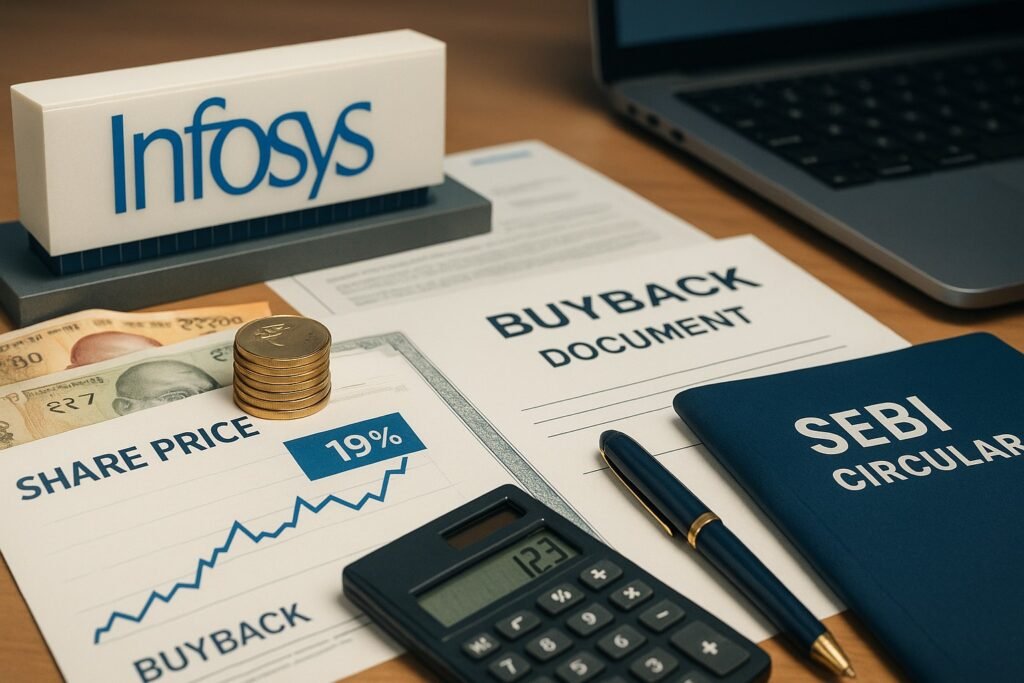
Infosys has approved a share buyback of ₹18,000 crore, the largest in the company’s history. The program will be executed at a price that is 19% higher than the recent market price, signaling strong confidence from the board in the company’s long-term prospects and cash flows.
The announcement puts the spotlight back on how India’s IT majors are using large cash balances. For existing shareholders, a buyback at a premium can be a direct way to unlock value. For the company, it reduces the number of shares outstanding, which can lift earnings per share over time and send a clear message about balance-sheet strength.
A 19% premium matters because it sets a clear, attractive reference point versus the stock’s recent trading range. Shareholders who choose to participate can tender their shares at the buyback price and receive cash. Those who do not participate will end up owning a slightly larger share of future profits per share if the total share count falls. In both cases, the signal is supportive: management believes the stock is worth more than where it trades today.
Buybacks are not the same as dividends. A dividend pays cash to everyone on the record date. A buyback invites shareholders to choose. If demand to tender is higher than the company’s planned size, the buyback is typically allotted on a proportionate basis. Retail investors often have a reserved quota in tender-offer structures, which can improve their chances of acceptance.
Why Infosys is doing this now:
IT spending has been uneven through global macro swings, but large clients continue to prioritize cost takeout, cloud, AI, and managed services. Infosys has focused on margin discipline and deal momentum while keeping a conservative balance sheet. A buyback of this scale suggests management expects cash generation to remain healthy and sees its own stock as a compelling use of capital compared with other options.
Historically, Infosys has returned cash through a mix of dividends and buybacks. This new program extends that track record and aims to smooth total shareholder returns even as quarterly demand cycles move up and down.
How the process usually works:
Large Indian buybacks are commonly done via a tender offer. Shareholders receive a window to submit shares through their brokers at the fixed buyback price. After the window closes, the company accepts shares up to the total buyback amount and returns unaccepted shares to investor accounts. Payouts land directly into linked bank accounts.
Investors watch a few dates closely: The record date to determine eligibility, the opening and closing dates of the tender window, and the expected settlement date. The company’s detailed letter of offer outlines all steps, including the retail investor reservation and the treatment of different shareholder categories.
The next updates to look for are the timetable, the exact mechanism, the record date, and the allocation details. Brokerages will publish acceptance-ratio estimates once the schedule is set and the share price adjusts toward the offer level. Analysts will also update earnings models to account for the smaller share base and any impact on cash yields and return ratios.
Market reaction often splits into two phases. The first is the announcement pop, where the stock moves toward the premium. The second is the digestion phase, where traders track acceptance expectations, arbitrage spreads, and any fresh commentary from management on demand, pricing, and margin outlook. Long-term investors tend to focus less on the spread and more on what the buyback says about management’s conviction and the company’s multi-year strategy.
For India’s IT services sector, this buyback is another sign of mature capital allocation. The industry generates steady cash, and large programs like this one help return excess capital while keeping investment capacity intact for AI, platforms, and capability acquisitions. If the operating backdrop improves into the next fiscal year, the combination of deal wins and a lower share count can lift per-share metrics even without dramatic top-line acceleration.
For Infosys, a record ₹18,000 crore buyback at a 19% premium is a strong statement. It rewards patient shareholders, underlines the company’s confidence, and sets a high bar for peers thinking about how to use large cash balances. As the formal documents land and dates are finalized, investors will have a clear path to participate—or to simply hold and benefit from a tighter share base over time.
The tender window will shut, the signal won’t. Stay with eBharat for the next tick.













